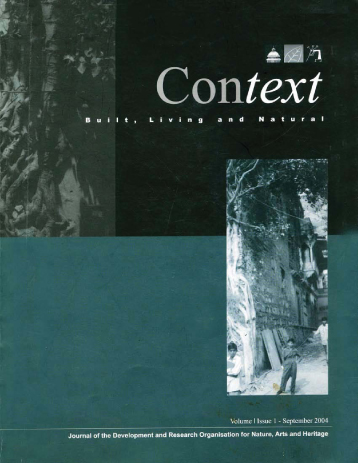Volume I Issue 1
Editorial
As professionals or researchers, be it architects, historians, environmentalists, conservationists or planners, we are often cocooned in our own professional or academic shells – providing expertise from a singular perspective. Although ‘Sustainability’ and ‘Conservation’ have become keywords for all professionals and researchers today yet the solutions provided fall short of a pluralistic approach. Despite an inherent linkage between built heritage, people and nature, a multidisciplinary attitude is still lacking in the country. “Context: Built, Living and Natural” provides a forum for exchange of ideas and dissemination of knowledge about the spectrum of people, place and architecture within the Indian scenario.
The introductory section ‘Compiling Records’ aims to regularly feature archival data in the form of measured architectural drawings, GIS mappings and community studies in different regions of India. This issue particularly records two interesting historic structures – the Narsimha temple in Uttaranchal and Ahirtola Ghat in Kolkata.
The articles in the ‘Methods and Approaches’ section comment on the prevailing methods used for conservation and sustainable projects as well as problems faced in implementation and future sustenance of specific conservation ventures. The first article in this section elaborates on the dynamism of indigenous knowledge accumulated by the local communities of India. Subsequent articles focus on issues of holistic approach to heritage planning, role of professionals in conserving traditional skills, integrated spatial planning, environmental insecurities, sustainable energy, children’s participation in environment management and community participation in planning. The article on ‘Gaiety Theatre’ presents an interesting dual saga of the architectural heritage and history of theatre in Simla.
The section on ‘Sustainable Solutions’ showcases three outstanding projects that successfully deal with issues of sustainability and conservation along with social upliftment - initiatives of CIBART in villages of Rahimawad and Kotwa, efforts on water conservation by Tarun Bharat Sangh and the changing face of Ralegansidhhi with motivations of Anna Hazare.
There is a deliberate mix of articles covering both in depth research as well as fieldwork and experiential notes as the journal emphasises on the essentialities of combining research work with ground realities to achieve success in such ventures.
We keenly look forward to your feedback on this first issue of “Context: Built, Living and Natural”.
- Shikha Jain, Chief EditorContents
EditorialCompiling Records
Narsimha Temple, Uttaranchal Research and Development Centre - Vastu Kala Academy
Ahirtola Ghats, Kolkata
- Debeshi Chakraborty
Indigenous Knowledge Systems for Sustainability
Sarita Anand and Divya Thimmaiya
The Ganga Riverfront in Varanasi: A Heritage Zone in Contestation
Rana P B Singh
What Else is Heritage and How to Ensure its Continuity: Emerging role of the profession of architecture for interventions in the growth and development of historic settlements
- Nimish Patel and Parul Zaveri
Gaeity Theatre Revisited-2004: Conservation for development
- Cheena Kanwal
Integrated Spatial Environmental Planning: A tool for environment protection
- Avinash Karera and Anurag Mishra
Environmental Refugees from Sundarbans
- Sugata Hazra
Society, Energy and Sustainable Development
- Patrick Devine-Wright
Children’s Participation in Environment Management
- Meenakshi Batra
Community Planning for Sustenance in a Heritage Environment
- Anshu Sharma and Manu Gupta<
Bamboo and Sustainable Living: Rahimawad and Kotwa Villages
- I V Ramanuja Rao and Inderpreet K Jaijee
Reviving the Johads of Alwar: Water conservation by the community
- Juhi Shah
The Story of Ralegansiddhi and Baburao Hazare
- S D Chavan and P S Bhonsle
Group of Monuments at Hampi-Phase I:
World Heritage Sites of India by Suchandra Bardhan
Monuments of Gurgaon District
by INTACH Gurgaon Chapter
Human Well Being and the Natural Environment by Partha Dasgupta
- Reviewed by Kishore Kumar

